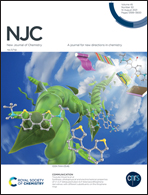A ratiometric fluorescence assay for bleomycin based on Cu2+-triggered cascade reactions and nanoparticle-mediated autocatalytic reactions†
Abstract
A simple strategy has been designed for ratiometric fluorescence sensing of BLM on the basis of Cu2+-triggered fluorogenic reactions coupled with nanoparticle-mediated autocatalytic reactions. On one hand, Cu2+ can oxidize ascorbic acid (AA) to produce dehydroascorbic acid (DHAA), which condensates with o-phenylenediamine (OPD) to form fluorescent 3-(dihydroxyethyl) furo[3,4-b]quinoxaline-1-one (DFQ) with strong emission at 436 nm. On the other hand, Cu2+ and OPD undergo a redox reaction to form fluorescent 2,3-diaminophenazine (DAP) showing strong emission at 565 nm and copper nanoparticles (CuNPs) that further catalyze this redox reaction. A ratiometric fluorescence system comes into being due to these two well-resolved emission peaks. Ascribed to the complexation of BLM with Cu2+, larger CuNPs are obtained which weaken the autocatalytic reaction between Cu2+ and OPD. Thus, the fluorescence intensities at 565 nm belonging to DAP decrease while those at 436 nm corresponding to DFQ change slightly. With the fluorescence intensity ratio (F436/F565) as a readout, BLM can be detected selectively and sensitively with a detection limit of 50 pM.



 Please wait while we load your content...
Please wait while we load your content...